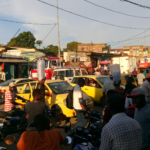Biological threats: A matter of balance
By Scientists Working Group on Biological and Chemical Weapons | February 2, 2010
The Graham-Talent WMD Commission asserted again last week that a bioterrorism attack that “will fundamentally change the character of life for the world’s democracies” is highly likely to occur within the next four years. The commission argues that the United States must urgently expand its efforts to develop vaccines and other medical countermeasures against potential bioterrorism agents.
We disagree with the commission on both points. It exaggerates the bioterrorist threat and proposes solutions that won’t produce the comprehensive approach needed to strengthen public health security.
The bioterrorist threat must be kept in perspective. Although many fictional “tabletop” scenarios and exercises have predicted bioterrorism catastrophes, these scenarios often have used unrealistic values for critical disease parameters and have routinely ignored the organizational and technical difficulties that terrorists would have in organizing, and successfully carrying out, a bioweapons attack. The history of both state-operated bioweapons programs and unsuccessful terrorist attempts to develop and use such weapons (e.g., the Japanese cult Aum Shinrikyo) have demonstrated, again and again, the significant difficulties that confront making and disseminating a biological weapon. The 2001 anthrax letter attacks, which were seen as validating the catastrophic scenarios, appear to have been executed with anthrax developed in a U.S. biodefense laboratory with capabilities vastly superior in scale and quality to anything a terrorist could achieve.
Advances in the life sciences may gradually put bioweapon capabilities closer within terrorist reach, but scientific and technological progress alone doesn’t warrant exaggeration of the bioterrorist threat. Rather than basing policy on worst-case scenarios, the United States should develop and conduct more plausible, sophisticated threat assessments that take into account the complex set of political, social, and technical factors that would affect bioweapons development and use.
Since the 2001 anthrax attacks, the federal government has spent nearly $60 billion responding to the perceived threat of bioterrorism. Roughly one-half of that money has funded detection systems, dramatically expanded research on bioweapon agents, and the development, procurement, and stockpiling of vaccines and other medical countermeasures against these agents.
As bioterrorism has commanded policy and funding attention over the last decade, domestic influenza-related deaths have likely exceed 300,000 people. The growing problem of multi-drug resistant tuberculosis, the lack of progress on reducing food-borne infections and disease outbreaks, and annual U.S. mortality figures from AIDS (14,000 deaths) and opportunistic infections such as MRSA (19,000 deaths) all speak to significant ongoing public health needs. Policy and funding decisions must be based on more than just mortality statistics. For instance, government is expected to respond effectively to acute disease outbreaks. Nonetheless, these figures underscore that continuing to emphasize and spend billions of dollars on measures to specifically counter exaggerated bioterrorist threats diverts attention and resources from other pressing natural disease threats and public health concerns.
Moreover, all the money and effort spent on biodefense hasn’t produced demonstrably better overall health security for the country. Detection systems remain unreliable triggers for immediate responses. Expansion of biodefense research has increased the number of people with access to dangerous pathogens and toxins, which increases the risk of accidents, infiltration by outside groups, or attack by a rogue insider. Programs to develop stockpiles of vaccines against bioweapon agents continue to face questions relating to efficacy, safety, shelf life, and timely distribution. Many other bioweapon-specific countermeasures will be useless against serious infectious disease problems, other acute public health threats, or even bioterrorist attacks that differ from the threat predicted. Despite promises of broad-based “synergies,” most of these efforts haven’t produced benefits for public health, as illustrated by the problems experienced in the responses to pandemic influenza A (H1N1).
Nonetheless, the Graham-Talent Commission wants U.S. policy makers to continue down this questionable path with more urgency, more money, and more intense focus on bioterrorist threats. Such an approach will exacerbate the political and funding gaps between defense against bioterrorism and protection of the U.S. population from naturally occurring infectious diseases. Strangely, the Commission points to the H1N1 pandemic as evidence that the United States should devote more funding to biodefense, when the proper conclusion to draw from the troubles experienced with H1N1 is that Washington isn’t paying enough attention to public health capabilities in its efforts to strengthen national health security.
Rather than continuing to argue, despite accumulated evidence to the contrary, that bioterrorism-centric policy and spending will produce meaningful and sustainable positive “spillover” effects for public health, a better, more comprehensive approach to national health security would focus on improving public health capabilities to respond to any kind of infectious disease threat. As the recently released U.S. National Health Security Strategy states, “Investments should focus, to the extent possible, on new technologies and countermeasures that could also have uses in non-public health emergency situations.”
This more comprehensive approach would focus political attention and fiscal resources on addressing important public health and national health security needs, including:
- Ensuring that the nation’s public health system is capable of addressing all public health needs, including infectious disease outbreaks. Only by ensuring adequate staffing and resources in all program areas will the United States build a sustainable public health system that can strengthen individual resistance to disease, improve early detection and treatment, and contain disease outbreaks, whether natural, deliberate or accidental.
- Increasing support for the basic tools necessary for public health surveillance and epidemiology, including skilled personnel, public health laboratories, and data collection, management, analytic, and information-sharing systems. In this respect, the roughly $15 billion in biodefense spending to strengthen state and local public health capacity and fund other public health efforts has been important and needs to be maintained and even enhanced.
- Enhancing animal disease surveillance and response capabilities and their integration with public health systems, which would improve the ability to rapidly detect and diagnose both animal and zoonotic infections and disease outbreaks, whether natural or deliberate.
- Improving disaster preparedness and response capabilities, especially medical surge capacity. The capabilities needed to respond quickly and effectively to an event that produces a large number of casualties are similar whether the event is a natural disease outbreak, a bioterrorism event, or a natural disaster such as an earthquake or tsunami.
- Strengthening research on new diagnostics, antibiotics, and antivirals for emerging or established diseases that cause significant mortality or morbidity. An ability to more rapidly develop, test, and verify the safety of new vaccines after an epidemic or pandemic is also important. However, emergency-response strategies shouldn’t overly focus on vaccination because vaccines usually need to be given prior to exposure. New vaccines will continue to take time to produce, and stockpiled vaccines are highly disease-specific (often even strain-specific) and often have a limited shelf life.
Public health in the United States faces many challenges; bioterrorism is just one. Policies need to be crafted to respond to the full range of infectious disease threats and critical public health challenges rather than be disproportionately weighted in favor of defense against an exaggerated threat of bioterrorism. Nine years after the anthrax letters, we know better than to expect narrowly construed biodefense policies to produce comprehensive health security for the U.S. people.
Together, we make the world safer.
The Bulletin elevates expert voices above the noise. But as an independent nonprofit organization, our operations depend on the support of readers like you. Help us continue to deliver quality journalism that holds leaders accountable. Your support of our work at any level is important. In return, we promise our coverage will be understandable, influential, vigilant, solution-oriented, and fair-minded. Together we can make a difference.
Topics: Biosecurity, Opinion















